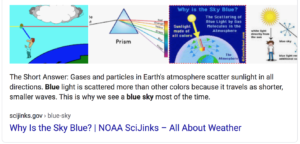The Guide To Optimizing For Featured Snippets
Rising to the top of Google’s search results is no simple feat, but definitely doesn’t mean you can’t win. Even if you aren’t in position 1 you’re still able to outrank it. How so? The holy grail of SEO: featured snippets.
In this post from Onimod Global’s experts, we’ll discuss what are featured snippets, what are their benefits for SEO, and how to optimize for them.
What is a featured snippet?
A featured snippet shows up as a block that contains the exact answer to your query. It’s a two to three sentence summary of text that appears at the top of Google. Featured snippets provide a fast and straightforward answer for a user’s query directly in the search results. Receiving a featured snippet is shown to result in more traffic for a given page.
The featured snippet appears to work on a more simplistic algorithm than Google’s “primary” one. This search result is significantly more influenced by simple on-page adjustments that very clearly define the topic to users and their search queries. See a simple example of a featured snippet below, allowing for users to get a fast answer to their question and also an opportunity to receive more traffic to their page.

How to optimize for the featured snippet
- Add a “what is” heading.
To start your featured snippet optimizations, you’ll want to look for a place in your content to add a “What Is [Keyword]” heading tag. This is a clear signal for Google that you have a fast and efficient information to share with a user with a specific search query. You will even notice at the top of this article, the first headline contains a “What is” statement, queuing Google to recognize information to include and what they can pull into the featured snippet. - Use sentence structure “is”
It is very important to use an “is” statement when optimizing for featured snippets. Structuring content this way appears to act as a trigger that allows Google to easily find the text that’s relevant for the featured snippet. - The topic must be fully explained in 2-3 sentences
Being concise is key. Feature snippets are meant to give users as much information about the topic as possible in a short amount of time.
Here are some general guidelines from Search Engine Land to follow while concisely defining featured snippets:
– The first sentence should define the topic
– The second and third sentences should describe 2-3 must-know facts about the topic
– Try to avoid using any extraneous phrasing in your definition
Contact Onimod Global
Looking for an agency to increase your SEO and optimize your website content? Reach out to us here!
Onimod Global releases the latest digital marketing news and essential marketing tips every Tuesday and Thursday! To catch up on the top digital marketing news and trends, click here. To find out more about who we are and what we do, click here.






